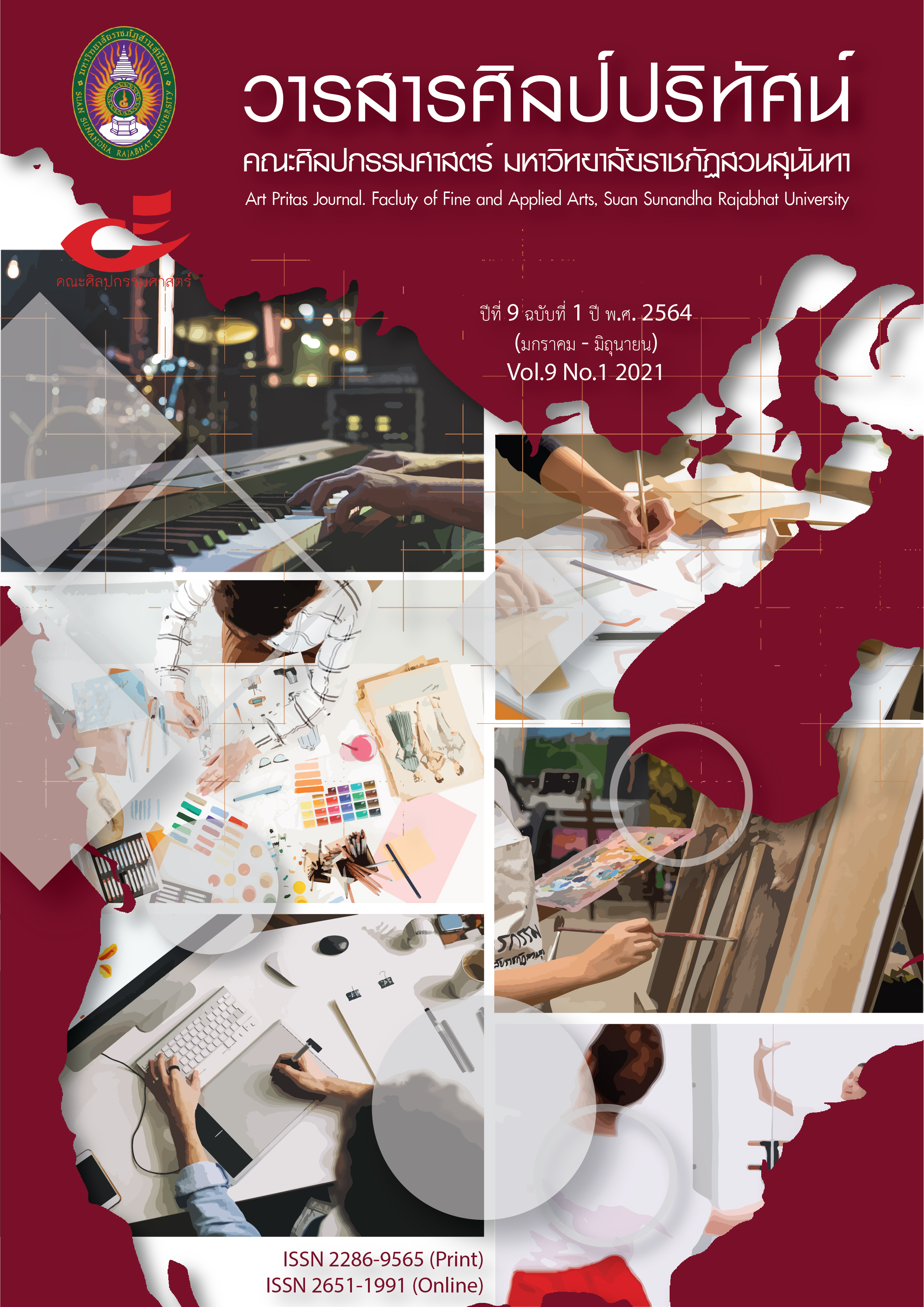การตีความผญา*อีสานเพื่อสร้างผลงานประติมากรรมร่วมสมัย
Main Article Content
บทคัดย่อ
ผลงานประติมากรรมที่มีบทผญาเป็นแรงบันดาลใจในการสร้างสรรค์ผลงาน เน้นที่ผญาคำสอนในอดีตที่มีวิธีการเปรียบเทียบสร้างภาพพจน์ในการทำความเข้าใจของสิ่งหนึ่ง ด้วยอีกสิ่งหนึ่ง ผญาภาษิตนี้เนื้อหาถึง บุคคลที่ได้รับการเคารพนับถือ ได้รับการยอมรับจากคนทั้งหลายว่าเป็นคนดี มีศีลธรรม แต่เมื่อพบกับอุปสรรค สิ่งยั่วยวนแต่เพียงน้อย ก็ไม่สามารถหักห้ามยับยั่งชั่งใจต่อสิ่งยั่วยุทั้งหลายที่เข้ามาได้ จนนำไปสู่การละเมิด พลั้งพลาดตัดสินใจ กระทำในสิ่งที่ผิด ผิดธรรมผิดวินัย การตีความภาษิตผญานี้เพื่อสร้างรูปทรงประติมากรรมโดยให้ความรู้สึกว่า ชีวิตที่สูญเสียจุดสมดุล เสียหลัก ผิดจากหลักการหรือหลักเกณฑ์ที่ตั้งไว้มีผลให้เส้นทางของการดำเนินชีวิตให้สมบูรณ์ ผิดพลาดล้มเหลว การใช้สัญลักษณ์แทนค่าในผลงานโดยเลือกเค้าโครงสิ่งที่คุ้นตาเป็นสัญญะแบบเหมือนจริง (iconic) เช่นรูปทรงมนุษย์ วัตถุ ที่สัมพันธ์หรือไม่สัมพันธ์กันมาประกอบสร้างเพื่อสื่อสารถึงเรื่องราว เหตุการณ์ อารมณ์ ความรู้สึก และทัศนคติของผู้สร้างสรรค์
โดยมีคุณค่าของงานประติมากรรม ความงามของรูปทรง เนื้อแท้ของวัสดุและรสชาติของการประกอบสร้างชิ้นงาน การเชื่อมโยงงานศิลปะเข้ากับวิถีชีวิต การเสนอประติมากรรมที่เสียสมดุลเพื่อสร้างสังคมที่มีความสมดุล เป็นกรณีศึกษาเพื่อสื่อให้เห็นแนวทางให้เราได้หันมาสำรวจตัวเอง เพื่อทำความเข้าใจตนเอง เข้าใจผู้อื่นและเคารพวัฒนธรรมอื่น ๆ มากขึ้น อันเชื่อได้ว่าจะนำมาซึ่งความสงบสุขของสังคมโดยรวม
Article Details
เนื้อหาและข้อมูลในบทความที่ลงตีพิมพ์ในวารสารศิลป์ปริทัศน์ ถือเป็นข้อคิดเห็นและความรับผิดชอบของผู้เขียนบทความโดยตรง ซึ่งกองบรรณาธิการวารสารไม่จำเป็นต้องเห็นด้วย หรือร่วมรับผิดชอบใดๆ
บทความ ข้อมูล เนื้อหา รูปภาพ ฯลฯ ที่ได้รับการตีพิมพ์ในวารสารศิลป์ปริทัศน์ถือเป็นลิขสิทธิ์ของวารสารศิลป์ปริทัศน์
เอกสารอ้างอิง
ชลูด นิ่มเสมอ. (2577). องค์ประกอบของศิลปะ. กรุงเทพฯ: อมรินทร์.
โชติวุฒิ พลวิเศษ. (2545). การตีความผญาเชิงจริยศาสตร์ที่ประยุกต์ใช้ในสังคมไทยปัจจุบัน. มหาวิทยาลัยขอนแก่น.
ชอบ ดีสวนโค. (2547). คำหลายความ รวมบทความเพื่อการศึกษาด้านสังคมวัฒนธรรม. ขอนแก่น: คลังนานาวิทยา.
เตยงาม คุปตะบุตร. (2557). ประสิทธิ์กับเรื่องที่ยังไม่ได้เล่า. สูจิบัตรงานแสดงนิทรรศการ, กรุงเทพฯ
ทรงวิทย์ พิมพะกรรณ์. (2557). ฟื้นฟูปัญญาผญาพาม่วน. ขอนแก่น: ขอนแก่นการพิมพ์.
ธีรยุทธ บุญมี. (2558). การปฏิวัติสัญศาสตร์ของโซซูร์เส้นทางสู่โพสต์โมเดอร์นิสม์. กรุงเทพฯ: สำนักพิมพ์วิภาษา.
ประทุม อังกูรโรหิต. (2556). ปรัชญาปฏิบัตินิยม รากฐานปรัชญาการศึกษาในสังคมประชาธิปไตย. กรุงเทพฯ:
สำนักพิมพ์แห่งจุฬาลงกรณ์มหาวิทยาลัย.
ไมเยอร์, ราล์ฟ. (2540). พจนานุกรมศัพท์และเทคนิคทางศิลปะ. มะลิฉัตร เอื้ออานันท์, ผู้แปล. กรุงเทพฯ: กรมวิชาการ
กระทรวงศึกษาธิการ.
พระครูกัลยาณสิทธิวัฒน์, (2560). ตัณหา ไม่ปรานีใคร. กรุงเทพฯ: โรงพิมพ์มหาจุฬาลงกรณราชวิทยาลัย.
โสรัจจ์ หงศ์ลดารมภ์. (2560). ปรัชญาทั่วไป. กรุงเทพ :สำนักพิม์แห่งจุฬาลงกรณ์มหาวิทยาลัย.


